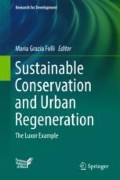Abstract
During the first decade of the new millennium, the attempt to transform the city of Luxor in Egypt into an open museum resulted in a number of undesirable outcomes. A major reason for these outcomes is the lack of knowledge regarding the differences between the ‘open museum’ concept on one hand and providing open air/outdoor areas for sightseeing on the other. This lack of knowledge was exacerbated by a failure to recognise the need to maintain harmony between the locals, the built environment and the heritage sites in Luxor. The adopted ‘open museum’ scenario did not consider that a visitor’s experience of Luxor should include the local and vernacular cultures along with the magnificent landscapes that are as old and majestic as registered monuments.
References
Abraham, G., Bakr, A., & Lane, J. (1999). Comprehensive development plan for the city of Luxor, Egypt: investment project#1, investment portfolio for proposed grant of US $40 million to the Arab Republic of Egypt for the restoration of the avenue of the Sphinxes. Cambridge: Abt Associates Inc.
Aghabi, O., Kane, H., Edmond, A., & Hassanballah, D. (1999). Creation of an open museum and Heritage district in Luxor city, Egypt. Cambridge: Abt Associates Inc.
Cerviere, G. (2015). Marco casagrande C-Lab. Oil Forest League, Potenza: Paracity. Urban Acupuncture.
El-Aref, N. (2008). The Karnak development project, complex improvements. Cairo: Al-Ahram weekly online, 16–22 October 2008, Issue No. 918 (official website of the Egyptian weekly journal of Al-Ahram: http://weekly.ahram.org.eg/Archive/2008/918/eg7.htm. Retrieved July 1, 2017).
Folli, M. G. (2010). The development of monumental and visual values of the sphinx alley: Final report. Project submitted in fulfillment of the collaboration protocol signed between Politecnico di Milano and Supreme Council of Antiquitie (SCA) Egypt).
Mckercher, B. (2002). Towards a classification of cultural tourists. International Journal of Tourism Research., 4(1), 29–38.
Mehta, H., Baez, A., & O’Loughlin, P. (2002). International Ecolodge Guidelines. Vermont: The international Ecotourism Society.
Rentzhog, S. (2007). Open air museums: The history and future of a visionary idea. Jamtle: Carlssons.
Shetawy, A. A., & Dief-Allah, D. M. (2006). Restoration of the avenue of the Sphinxes: Between government enforcement and local rejection in Luxor, Egypt. Journal of Al Azhar University Engineering Sector, 9(3), 887–901.
Touregypt. (2017). Luxor tours: 1996–2017. http://www.touregypt.net/luxor/tours.html. Retrieved July 2, 2017.
Internet Sources
Google earth. Source: http://www.panoramio.com/photo/127202312. Retrieved July 3, 2017.
Author information
Authors and Affiliations
Corresponding author
Editor information
Editors and Affiliations
Rights and permissions
Copyright information
© 2018 Springer International Publishing AG
About this chapter
Cite this chapter
Abulnour, A. (2018). Acupuncturing Luxor: Reinventing the Open Museum Concept. In: Folli, M. (eds) Sustainable Conservation and Urban Regeneration. Research for Development. Springer, Cham. https://doi.org/10.1007/978-3-319-65274-0_7
Download citation
DOI: https://doi.org/10.1007/978-3-319-65274-0_7
Published:
Publisher Name: Springer, Cham
Print ISBN: 978-3-319-65273-3
Online ISBN: 978-3-319-65274-0
eBook Packages: Social SciencesSocial Sciences (R0)

